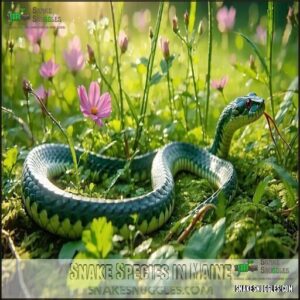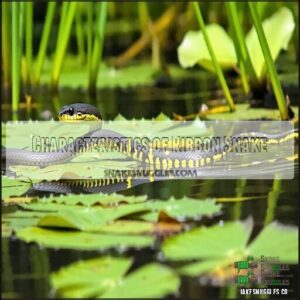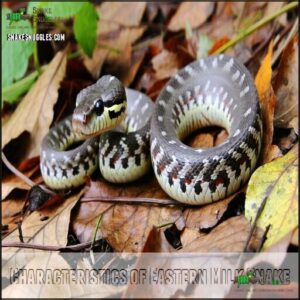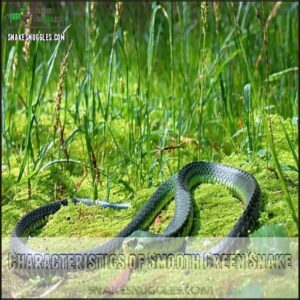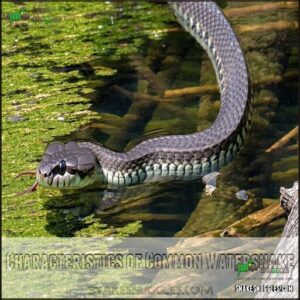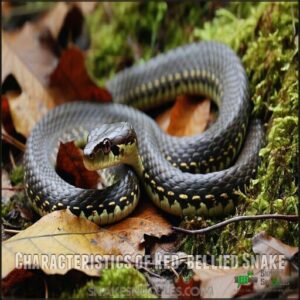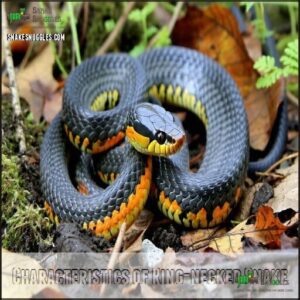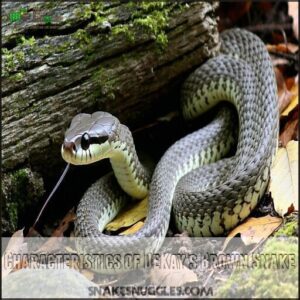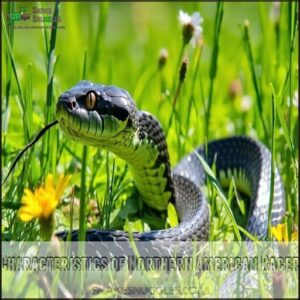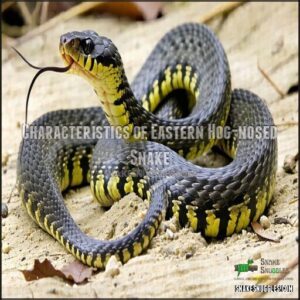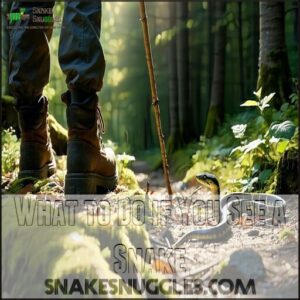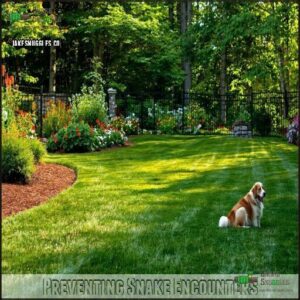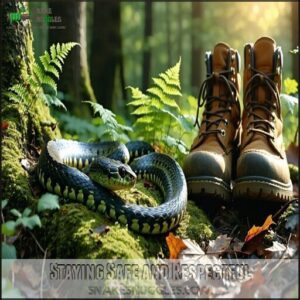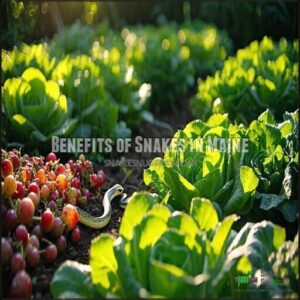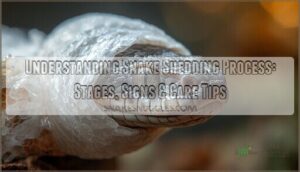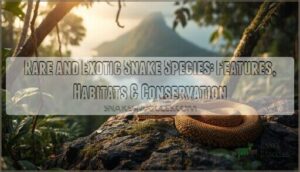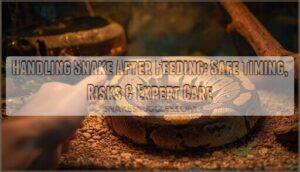This site is supported by our readers. We may earn a commission, at no cost to you, if you purchase through links.
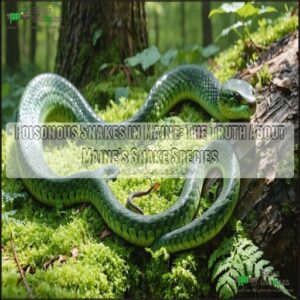 You can relax—there are no poisonous snakes in Maine.
You can relax—there are no poisonous snakes in Maine.
In fact, Maine doesn’t have any venomous snake species at all, so encounters here are as safe as they come.
The state is home to nine harmless species, like the Smooth Green Snake and the Eastern Milk Snake, which are shy and non-threatening.
Some, like the endangered Northern Black Racer, are even rare to spot.
Snakes in Maine play a pivotal role in controlling pests, so they’re great to have around.
Want to keep your yard snake-free anyway? Proper landscaping and sealing gaps in your home can work wonders!
Table Of Contents
- Key Takeaways
- Snake Species in Maine
- Identifying Snakes in Maine
- Characteristics of Ribbon Snake
- Characteristics of Eastern Milk Snake
- Characteristics of Smooth Green Snake
- Characteristics of Common Watersnake
- Characteristics of Red-bellied Snake
- Characteristics of Ring-necked Snake
- Characteristics of DeKay’s Brown Snake
- Characteristics of Northern American Racer
- Characteristics of Eastern Hog-nosed Snake
- Snake Encounters in Maine
- Benefits of Snakes in Maine
- Maine’s Unique Snake-Free Status
- Beyond Snakes in Maine
- Frequently Asked Questions (FAQs)
- Are There Any Snakes in Maine That Have Distinctive Markings?
- Are There Any Snakes in Maine That Are Endangered?
- Are There Any Other Animals in Maine That Can Be Dangerous?
- Are There Any Snake-specific Conservation Efforts in Maine?
- Are There Any Snakes in Maine That Hibernate in the Winter?
- Are there any poisonous snakes in the state of Maine?
- What 3 states have no venomous snakes?
- Why does Maine not have poisonous snakes?
- Do we have copperheads in Maine?
- Were there ever rattlesnakes in Maine?
- Conclusion
Key Takeaways
- Maine doesn’t have any poisonous snakes, making it one of only three U.S. states without venomous species.
- Cooler climates and short summers prevent venomous snakes, like copperheads or rattlesnakes, from thriving in Maine.
- Timber Rattlesnakes once lived in Maine but were extirpated over a century ago due to habitat changes and cold temperatures.
- All nine native snake species in Maine, such as the Smooth Green Snake and Eastern Milk Snake, are completely harmless and beneficial for pest control.
Snake Species in Maine
Maine is home to nine species of snakes, and none of them are venomous.
From the smooth green snake to the northern water snake, each species plays a unique role in the local ecosystem.
Ribbon Snake
The Ribbon Snake, a common sight in Maine’s wetlands, is easy to spot with its sleek, dark body and bold yellow stripes.
Easily identified by its dark body and vibrant yellow stripes, the Ribbon Snake gracefully thrives in Maine’s lush wetlands.
Growing up to 35 inches, it thrives near marshes and streams, blending into its watery world.
- Ribbon Snake Habitat: Prefers high vegetation near water.
- Ribbon Snake Diet: Eats frogs, small fish, and other amphibians.
- Ribbon Snake Behavior: Docile, quick to flee rather than confront.
- Snake Identification Maine: Slim build, bright stripes, harmless to humans.
This harmless species plays a key role in balancing Maine’s ecosystems.
Eastern Milk Snake
The Eastern Milk Snake (Lampropeltis triangulum) stands out among Maine snakes with its striking pattern of brown or red blotches on a tan or gray background.
Found primarily in central and southern Maine, these non-venomous snakes play a key role in rodent control.
Easily identified by their smooth scales and checkered belly, they thrive in various habitats like wooded areas and fields.
| Feature | Description | Significance |
|---|---|---|
| Length | Up to 36 inches | Helps with snake identification Maine enthusiasts. |
| Habitat | Central and southern Maine | Versatility in snake habitats Maine. |
| Conservation | Non-threatened | Important for rodent control and balanced ecosystems. |
Smooth Green Snake
The Smooth Green Snake is one of Maine’s most striking snake species, effortlessly blending into grassy landscapes with its vivid, leaf-green scales. If you spot one, consider it nature’s gardener—these slender, nonvenomous snakes are fantastic for pest control.
Measuring up to 26 inches, smooth green snakes prefer moist habitats like meadows, wetland edges, and lush backyard gardens. Their diet consists mostly of insects, spiders, and small invertebrates, making them a silent ally in protecting your plants. With a white or yellow belly and a red tongue tipped in black, they stand out among Maine snakes.
These snakes are harmless to humans. They’re incredibly docile, relying more on their camouflage than confrontation. Encountering a smooth green snake in your backyard is a reminder of nature’s balance.
- **Marvel at its emerald-green beauty, perfect for snake identification.
- **Enjoy the backyard benefits of natural pest control.
- **Support snake conservation by appreciating this gentle species.
- **Celebrate Maine snakes, all nonvenomous and fascinating.
Common Watersnake
The Common Watersnake is one of the most fascinating snake species Maine has to offer.
Found near ponds, lakes, and rivers across southern, eastern, and central regions, these skilled swimmers are perfectly suited to aquatic habitats.
Their Watersnake Habitat includes rocky shorelines and shallow waters where they easily hunt fish and amphibians—a Watersnake Diet they handle with remarkable expertise.
Measuring up to 4 feet 5 inches, their bodies showcase bold patterns of reddish-brown, gray, or black with dark crossbands.
Despite their intimidating look, Watersnake Behavior is typically shy and defensive.
When startled, they might flatten their heads to mimic venomous snakes, but it’s all bluff—these Maine snakes are harmless.
Here’s a quick look at their traits:
| Feature | Description |
|---|---|
| Pattern | Dark crossbands |
| Belly Color | Yellow or white |
| Maximum Size | 4 feet 5 inches |
Maine’s Common Watersnake proudly represents non-venomous snake diversity!
Red-bellied Snake
Curiosity often draws attention to the Red-bellied Snake—one of the smallest and most unique of Maine’s snakes. Recognizable by its vivid red-orange underside, this snake’s upper body comes in shades of brown, gray, or even olive, giving it excellent camouflage in moist, wooded habitats.
Despite its striking appearance, the redbellied snake is harmless. It thrives in damp, shaded areas where its favorite prey—slugs and earthworms—are abundant. You might encounter them in gardens or near compost piles, quietly performing pest control.
Here’s how to engage with this common Maine snake:
- Location matters: They prefer woodlands, wetlands, and mulched garden beds.
- Diet plays a role: They survive on slugs, helping maintain garden health.
- Behavior surprises: They rarely flee but might flatten their body defensively.
Keep an eye out—this tiny treasure highlights Maine’s diverse snake species.
Ring-necked Snake
You’ll recognize the ring-necked snake by its slender body and vivid neckband variations—usually yellow, orange, or red.
Found in Maine’s woodlands, these small snakes prefer moist, rocky habitats.
They’re harmless but may curl their tails to reveal bright undersides when startled.
Add these to your Maine reptile guide for snake identification! Like all common Maine snakes, they help manage insect populations and don’t bite unless firmly handled.
DeKay’s Brown Snake
DeKay’s brown snake, one of the common Maine snakes, prefers quiet spots like forest edges and gardens.
Known for their subtle coloring and tiny black facial dots, these harmless snakes are experts in camouflage.
Their diet consists of slugs and worms, making them great natural pest controllers. When startled, they’ll quickly flee rather than confront.
Found near coastal areas up to Ellsworth, these shy snakes thrive in moist habitats, embodying the reserved charm of Maine snakes. They share habitats with Eastern Garter Snakes.
Northern American Racer
The Northern American Racer isn’t your typical Maine snake—this speedster brings energy to southern Maine’s open spaces.
It zips through grasslands and meadows so fast, you might think it’s in a hurry to stay ahead of the competition. Reaching up to five feet long, this glossy black or blue-black snake is sleek, with smooth scales and a pale underside for contrast.
Here’s what you should know:
- Racer Habitat: Prefers sunny areas like fields and forest edges.
- Racer Diet: Eats rodents, frogs, and insects, making it a valuable natural pest controller.
- Racer Behavior: Shy and non-aggressive—its first instinct is to flee, not fight.
- Racer Threats: Habitat loss has made sightings rare.
- Racer Conservation: It’s endangered in Maine, highlighting the need to protect its environment.
While not venomous, it’s a fascinating part of Maine wildlife and a rare treat to spot!
Eastern Hog-nosed Snake
The Eastern Hog-nosed Snake isn’t one of Maine’s nine native species, but it’s worth knowing if you’re visiting nearby states.
Known for its Hognose Defense, this snake flattens its head or dramatically “plays dead” when threatened.
Preferring sandy areas and loose soil, its Hognose Habitat supports its love for toads, a key part of its Hognose Diet.
Sadly, Hognose Conservation efforts highlight its declining presence due to habitat loss, which is a critical issue for the Hognose species and its Hognose Defense mechanism, and also affects its Hognose Habitat.
Identifying Snakes in Maine
You can identify Maine’s snakes by observing their size, color patterns, and habitat preferences.
None are venomous, so you don’t need to worry about dangerous encounters while learning to distinguish them.
Characteristics of Ribbon Snake
The Ribbon Snake is one of the most intriguing Maine snakes, thriving near water-rich environments.
- Ribbon Snake Identification: Slender with dark brown bodies and striking yellow or green stripes.
- Ribbon Snake Habitat: Found around ponds, streams, and marshy areas in southern and central Maine.
- Ribbon Snake Behavior: They’re timid, often fleeing rather than engaging with humans.
- Ribbon Snake Diet: Amphibians like frogs and tadpoles, helping balance Maine’s ecosystem.
These harmless, agile snake species are a true asset to Maine’s wildlife.
Characteristics of Eastern Milk Snake
The Eastern Milk Snake, a nonvenomous Maine resident, is easy to spot with its distinctive markings.
It thrives in central and southern regions, often around farms and homes.
These snakes grow up to 36 inches, featuring tan or gray scales with black-bordered reddish-brown blotches.
Their smooth scales add gloss, and their bellies display a striking black-and-white checkered pattern.
| Feature | Characteristics |
|---|---|
| Size | Up to 36 inches long |
| Pattern | Brown blotches with black borders |
| Belly | Black-and-white checkered design |
| Scale Texture | Smooth and shiny |
Though often mistaken for venomous snakes, they’re docile and essential for rodent control.
Characteristics of Smooth Green Snake
While milk snakes display distinctive patterns, the Smooth Green Snake offers a striking contrast with its vibrant emerald coloration.
You’ll easily identify this non-venomous species by its slender body (14-20 inches), glossy scales, and characteristic white or yellow belly. These gentle creatures inhabit meadows and moist areas throughout Maine.
When identifying smooth green snakes, note these key features:
- Uniform bright green dorsal coloration providing perfect camouflage abilities
- Completely smooth scales without the ridge found on many Maine snake species
- Subtle, graceful movements rather than aggressive displays when encountered
Their diet consists primarily of insects, making them beneficial for natural pest control. Maine wildlife enthusiasts appreciate these harmless snakes for their habitat preference in grassy areas and their conservation status remains stable throughout the state.
Characteristics of Common Watersnake
The Common Watersnake stands out among Maine snake species with its robust build and distinctive coloration.
You’ll typically find these non-venomous swimmers reaching up to 4 feet 5 inches in length.
| Feature | Characteristics | Identification Tips |
|---|---|---|
| Appearance | Reddish-brown to gray with dark crossbands | Look for diamond pattern that fades with age |
| Habitat | Lakes, ponds, streams, marshy areas | Often seen basking on rocks or logs |
| Diet | Fish, frogs, salamanders, crayfish | Hunts primarily in water |
| Behavior | Excellent swimmer, may flatten body when threatened | Will release musky odor if handled |
| Range | Southern Maine waterways | Absent from northern regions |
These skilled swimmers prefer aquatic environments and help control fish populations in Maine snake habitats, making them an important part of the ecosystem. They are excellent swimmers and are often found in areas with abundant water, such as lakes and streams. The Common Watersnake’s ability to thrive in these environments is due to its distinctive coloration and adaptability.
Characteristics of Red-bellied Snake
Hidden beneath forest debris, the Red-bellied Snake (Storeria occipitomaculata) is one of Maine’s most distinctive non-venomous species.
You’ll immediately recognize this snake by its chestnut to gray dorsal coloration and striking brick-red belly. Though small at just 8-10 inches, these woodland dwellers are efficient predators with specific habitat preferences.
Five key identification features of Red-bellied Snakes:
- Distinctive red belly color ranges from coral to brick-red
- Three light spots behind the head forming a collar
- Keeled scales giving a slightly rough appearance
- Small size rarely exceeding 10 inches
- Tendency to curl upper lip when threatened
Characteristics of Ring-necked Snake
Moving from the modest red-bellied snake, you’ll find the Ring-necked Snake equally fascinating but distinctly different.
This small Maine snake species measures just 10-15 inches long, featuring a sleek blue-gray to slate-colored body with its signature yellow, orange, or red neckband variation.
You can identify this non-venomous snake by four key characteristics:
- A bright, distinctive collar (neckband) just behind the head
- Smooth scales with a yellow underbelly, sometimes featuring orange rings
- Small size compared to other Maine snakes, rarely exceeding 15 inches
- Defensive behavior of curling its tail to display warning colors when threatened
Ring-necked snakes prefer habitat preferences that include moist woodland areas with plenty of leaf litter and hiding spots.
They’re primarily nocturnal, spending daylight hours concealed under rocks and logs throughout central and southern Maine, hunting invertebrates for their diet specifics after dark.
Characteristics of DeKay’s Brown Snake
When exploring Maine’s coastal regions, you’ll encounter DeKay’s brown snake within 50 miles of the shoreline.
This small species rarely exceeds 14 inches in length. Their serpentine movement allows them to navigate various terrains.
| Feature | Description | Identification Tip |
|---|---|---|
| Body | Gray-brown with keeled scales | Look for light center stripe with black dots |
| Face | Small, rounded head | Black vertical streaks behind each eye |
| Habitat | Woodland areas from Massachusetts border to Ellsworth | Found under logs and rocks |
The key characteristics of this species can be identified by examining its body, face, and habitat, making it easier to spot a DeKay’s brown snake in its natural environment.
Characteristics of Northern American Racer
While brown snakes prefer forest floors, the Northern American Racer takes to open spaces with impressive presence.
You’ll recognize this snake by its sleek, bluish-black body that can stretch up to 5 feet long, making it Maine’s largest snake species.
Its Racer Speed reaches 3.5 mph as it glides through York County’s fields and forest edges—its primary Racer Habitat.
Though intimidating in size, this non-venomous snake focuses on Racer Diet staples like rodents and smaller reptiles.
When encountered, expect Racer Behavior to favor retreat over confrontation, as these beneficial maine snakes prefer escape.
Characteristics of Eastern Hog-nosed Snake
After learning about the swift Northern American Racer, you’ll find the Eastern Hognose Snake quite different with its most distinctive feature—an upturned snout resembling a pig’s nose.
This specialized adaptation helps it dig through sandy soil in its preferred habitat of open woodlands and fields.
When threatened, the Eastern Hognose Snake displays remarkable defense mechanisms:
- It flattens its neck and head cobra-style, creating an intimidating appearance
- It hisses loudly while coiling its body in a defensive posture
- It may strike repeatedly with a closed mouth (it’s all bluff!)
- If these tactics fail, it’ll roll onto its back and play dead convincingly
Despite its dramatic defensive behaviors, this snake is completely harmless to humans.
Color variations range from yellow-brown to gray with dark blotches. Its scale patterns are keeled (ridged), giving it a rough texture.
The hognose’s diet specifics center around toads and other amphibians, which it subdues using mild rear-fanged venom.
Snake Encounters in Maine
You’ll encounter Maine’s nine non-venomous snake species primarily near water bodies, gardens, or while hiking trails during spring and summer months.
When you spot a snake, maintain your distance and remain calm, as these beneficial creatures typically flee rather than confront humans.
What to Do if You See a Snake
When you encounter a snake in Maine, remain calm. Since all Maine snakes are non-venomous, these encounters pose minimal risk.
- Maintain a distance of at least 6 feet, allowing the snake to retreat naturally
- Make slow, deliberate movements to avoid triggering defensive behaviors
- Wear closed-toe shoes and long pants when hiking in snake habitats
- Use a walking stick to probe vegetation before stepping through dense areas
Most Maine snakes flee rather than confront humans. Consider wearing specialized protective footwear for enhanced safety in snake-prone areas. Take photos from a safe distance for proper snake identification. If concerned about pets or children, call professionals for guidance on how to handle the situation.
Snake in The Home
Finding a snake in your home can send shivers up your spine, but remember—Maine homes only host non-venomous species.
When you spot a snake indoors, resist the urge to panic. For a coiled snake, use the wastebasket method by placing a large container over it with something heavy on top until help arrives.
For active snakes, try herding them toward an open door using a broom—never attempt handling them yourself. Effectively confine the snake by closing interior doors and blocking snake entry points under doorways with towels.
Snakes seek shelter in dark, undisturbed areas. Many homeowners call local animal control or professional snake removal services for safe, humane intervention.
Maine snake control specialists can also remove your unwanted visitor and provide advice on creating snakeproof homes to prevent future encounters.
Preventing Snake Encounters
Preventing snake encounters in Maine is simple and effective with a few proactive steps. Regular yard maintenance is key; keep grass trimmed and clear away debris.
For extra protection, use natural snake deterrent methods like cedar oil or sulfur. Pet safety matters—monitor outdoor play areas.
On trails, practice proper trail etiquette and stick to clear paths. Remember, snakes prefer to avoid humans.
For added safety in your yard, consider installing a specialized garden fence.
Try these tips to enjoy a snake-free yard. To further secure your outdoor space, follow these steps:
- Trim overgrown shrubs and grass.
- Seal cracks in home foundations.
- Remove wood or leaf piles.
- Use fine mesh fencing for gardens.
By taking these proactive steps, you can significantly reduce the likelihood of snake encounters, ensuring a safer environment for both you and your pets, and helping to maintain a safe outdoor space with proper trail etiquette.
Creating a Snake-Free Zone
Keeping snakes away from your property starts with making your yard less inviting. Snakes aren’t planning a housewarming party, but they’ll stick around if you provide shelter and food.
Here’s how to create snakeproof yards and gardens:
- Lawn Maintenance: Keep grass short and trim shrubs so snakes have fewer hiding spots. Clear out brush piles and fallen leaves.
- Sealing Entryways: Cover foundation cracks, vents, and utility gaps with fine mesh or foam to block slithering guests.
- Repelling Methods: Place bird feeders 30+ feet from your home to avoid attracting rodents – a snake’s favorite snack.
- Habitat Modification: Install snake-proof fencing angled outward and buried at least 6 inches deep to stop sneaky visitors.
- Professional Assistance: Need backup? Humane snake control services can help guarantee snakeproof landscaping.
With these tips, you can enjoy a calm, snake-free zone at home. Consider purchasing effective snake barriers for added protection.
Staying Safe and Respectful
If you spot a snake while exploring Maine’s outdoors, stay calm and focus on keeping a safe distance. Maine’s snakes are harmless, but giving them space protects both you and them.
Avoid disturbing the snake—step back slowly, and make sure it has a clear escape route. Snake safety isn’t complicated, but it starts with a calm reaction and a pair of protective footwear.
Don’t handle snakes, even if they appear small or docile. Bites are rare but could lead to minor infections. Try observing snake behavior from a respectful distance instead.
- Don’t corner or trap snakes—they’re more interested in leaving than staying.
- Teach coexistence ethics—snakes reduce pests and are essential to Maine’s ecosystem.
Benefits of Snakes in Maine
You mightn’t realize it, but snakes play a pivotal role in keeping Maine’s ecosystems balanced.
By controlling pests like rodents and insects, they help protect crops, gardens, and even your home.
Snakes Are Beneficial
Maine’s snakes play a pivotal role in maintaining the state’s ecosystem balance, even if their slithering presence might make your skin crawl.
These natural pest control experts keep rodent and insect populations in check, protecting crops and reducing disease risks. As environmental indicators, their health reflects the broader condition of Maine wildlife and habitats.
By preying on pests, they contribute to essential predator-prey dynamics, helping ecosystems thrive. Supporting snake conservation guarantees these essential ecological roles continue.
Without Maine’s snakes, disrupted ecosystems could face cascading effects—removing one thread risks unraveling the whole environmental fabric. Embracing their contributions benefits us all, as they are natural pest control experts and play a crucial role in maintaining the ecosystem balance, which is vital for the state’s environmental indicators.
Most Maine Snakes Are Harmless
It’s reassuring to know Maine snakes are completely non-venomous and pose no real danger to humans.
As one of the few U.S. states without venomous species, Maine offers a unique sense of safety in regards to these fascinating creatures.
By understanding typical snake behavior, you’ll see just how harmless they are. Most snakes in Maine:
- Shy away from people and retreat when approached.
- Pose no health risk, even in the rare event of a bite.
- Prefer fleeing rather than showing aggression.
- Play important ecological roles by controlling pests like insects and rodents.
With proper snake identification and providing them space, you’ll see there’s no reason for fear. Instead, focus on respect and appreciation for their role in Maine wildlife. Snake encounters can be safe, easy, and beneficial.
Coexistence is Possible
Coexisting with Maine snakes is simpler than you think. By taking practical steps, you can guarantee safe distances and peaceful interactions.
Trim overgrown shrubs or tall grass to limit snake habitats in your yard. Seal cracks in your home’s foundation—snakes are experts at sneaking into gaps. Removing attractants like excess water or rodent food sources discourages unwanted visitors.
Respectful observation matters. Maine snakes, though harmless, play essential roles in rodent and insect control.
Protect snake habitats while staying safe, as habitat preservation benefits both you and local wildlife. Education about Maine snakes guarantees confidence in managing snake encounters responsibly.
Respect Their Role in The Ecosystem
Respecting snakes appreciating the essential role they play in Maine’s ecological balance.
Their contributions go far beyond just being backyard wildlife.
Here’s why snakes are indispensable:
- They provide natural pest control by managing rodent and insect populations.
- Their presence supports the food web as prey for hawks, owls, and other predators.
- Snake sightings indicate a healthy ecosystem balance critical to Maine wildlife.
- Snakes help researchers study habitats and biodiversity through Maine herpetology initiatives.
- Snake conservation in Maine protects wetlands, forests, and the species that call these spaces home.
Every snake benefits nature.
Learn More About Snakes
Want to learn more about snakes? Start by exploring snake behavior and habitat diversity through nature centers or field guides.
Since there are no venomous snakes in Maine, it’s safe to observe these fascinating creatures up close. Maine snake sightings often involve species that help with rodent control, aiding ecosystem balance.
Explore Maine herpetology and debunk local myths about snakes—they deserve better PR! Understanding poisonous snake identification elsewhere shows how Maine’s snake population is unique.
Expand your knowledge and support conservation efforts because education transforms fear into appreciation.
Maine’s Unique Snake-Free Status
You won’t find any venomous snakes in Maine, making it one of only three U.S. states with this unique status.
Thanks to its cooler climate and specific habitats, Maine remains a safe place for snake encounters.
No Venomous Snakes in Maine
Maine stands out as a haven for nature lovers thanks to the venomous snakes maine—or rather the absence of them! As one of three states with no venomous snakes (along with Alaska and Hawaii), the state offers peace of mind for hikers, campers, and wildlife enthusiasts exploring its rugged beauty.
The Extirpated Rattlesnake—timber rattlesnake—was last seen in Maine around 1860, cementing its venomous absence reasons. Today, maine wildlife boasts nine harmless snake species, making encounters safe and valuable for rodent control.
For snake safety maine, remember:
- Learn Maine’s snake species to ease fears (facts > fear!)
- **All local snakes are nonvenomous—explore confidently.
- **Respect snakes’ space during sightings.
- Embrace Maine’s unique fauna!
Snake Bites in Maine
How often do you hear about snake bites in Maine? Rarely, because all of Maine’s snakes are non-venomous.
If bitten, don’t panic—focus on quick first aid. Wash the wound with soap and water to prevent infection.
Unlike bites from venomous snakes in other states, Maine’s snake bites rarely require medical treatment. Recovery usually takes a day or two.
For added snake safety, avoid handling snakes unnecessarily!
Comparing Snake Bites Across The US
Snake bites across the US vary in severity due to regional differences in venomous species.
States like Arizona or Texas face higher risks, thanks to rattlesnakes and copperheads.
Here’s what influences bite statistics:
- Regional Variations: Different states host species with unique venom types.
- Bite Severity: Rattlesnake envenomation requires quick medical treatment.
- Snake Bite Treatment Access: Rural areas may lack immediate care.
- Prevention Methods: Footwear and awareness reduce risks.
- US States: Maine remains safest—zero venomous species!
Safety of Observing Snakes in Maine
Observing snakes in Maine is a stress-free experience since the state’s wildlife is venom-free. Snake encounters here are all about fascination, not fear.
To enjoy these fascinating creatures safely, follow a few precautions during your adventures.
- Stay at a safe distance: Six feet is ideal to observe respectfully while giving snakes room to avoid provoking them.
- Wear protective gear: Closed-toe shoes and long pants help during treks in Maine’s woodlands and marshes.
- Use a walking stick: Brushing vegetation ahead signals your presence and helps avoid startling snakes.
- Identify aggression: Defensive behaviors like flattening or retreating aren’t threats—just personal space signs.
Snake safety boils down to awareness and calmness. Knowing how to perform snake bite first aid is still valuable knowledge.
Always cherish Maine’s wildlife by observing thoughtfully.
Beyond Snakes in Maine
While Maine’s snakes are non-venomous, the state is home to a variety of other fascinating wildlife.
From moose to wolf spiders, there’s plenty to learn about the creatures that share Maine’s unique ecosystems.
Moose in Maine
Moose outnumber people in some Maine areas, with a population of around 60,000.
These giants thrive in wetlands and forests, playing a key role in conservation. Stay cautious—moose behavior shifts during mating season. Admire from afar and appreciate their contribution to Maine wildlife.
Here’s a quick breakdown:
| Moose Fact | Detail | Fun Note |
|---|---|---|
| Population | 60,000–70,000 | Largest in the lower 48 states |
| Habitat | Forests, wetlands | Prefer woodland edges too |
| Behavior | Calm but defensive in mating | Admire, but keep a safe distance |
| Threats | Collisions with vehicles | Over 500 annually |
| Conservation | Maintains healthy ecosystems | Icon of Maine’s wild landscapes |
Wolf Spiders in Maine
Maine’s wolf spiders, though imposing with their striped bodies and quick movements, are allies in disguise.
You won’t find these beneficial predators spinning webs; instead, they hunt pests across leaf litter and grassy spots.
Unlike venomous snakes (which Maine lacks), their bites are rare and harmless, causing little more than mild irritation.
If you’re curious about Wolf Spider ID or spider benefits, remember these arachnids play a pivotal role in controlling pests and balancing Maine wildlife ecosystems.
Other Wildlife Encounters in Maine
If snakes aren’t your thing, Maine offers plenty of other fascinating wildlife to observe safely and responsibly.
Whether you’re roaming the woods or relaxing by a lake, staying informed about local species guarantees everyone—humans and animals—stays safe.
Here are four common animals you might spot:
- Black Bears: Generally shy but fiercely protective. Keep food stored securely and maintain at least 100 yards of space.
- Moose: Known for their size and strength; a bull moose can be dangerous, especially during the rut. Stay 50 yards away to avoid trouble.
- White-Tailed Deer: Graceful and abundant, especially at dawn or dusk near forest edges.
- Bald Eagles: A delight for birdwatchers, often seen over lakes. Respect birdwatching ethics—observe quietly.
Remember to leash dogs, avoid feeding wildlife, and check for ticks after outdoor excursions.
Respecting Wildlife in Maine
In Maine’s great outdoors, showing respect for wildlife is essential for ethical interactions and wildlife coexistence.
Every creature, from moose to non-poisonous snakes, plays a pivotal role in habitat preservation.
Keep a safe distance from animals and observe responsibly—interrupting natural behaviors can harm both you and them.
Snake encounters in Maine are harmless but still require caution; avoid touching or cornering them.
By supporting conservation efforts and enjoying Maine wildlife ethically, you’ll enhance your experience and help preserve its delicate ecosystems for generations.
Frequently Asked Questions (FAQs)
Are There Any Snakes in Maine That Have Distinctive Markings?
Don’t worry, Maine’s snakes are all harmless!
Many have cool markings—like the ring-necked snake’s orange neckband or the milk snake’s brown blotches.
The bright green smooth green snake is a real standout, too!
Are There Any Snakes in Maine That Are Endangered?
You won’t find any endangered snakes in Maine.
All nine species are non-venomous and common in their habitats.
Some, like the smooth green snake, are monitored, but they’re not listed as endangered.
Are There Any Other Animals in Maine That Can Be Dangerous?
You might encounter black bears, moose, or even ticks in Maine.
Black bears avoid humans but can be dangerous if provoked.
Moose are massive and unpredictable, while ticks carry Lyme disease, so stay cautious outdoors.
Are There Any Snake-specific Conservation Efforts in Maine?
Maine focuses on habitat protection and education to conserve its nine harmless snake species.
Efforts include preserving wetlands, raising public awareness about their ecological benefits, and discouraging fear-based actions to guarantee these snakes thrive peacefully.
Are There Any Snakes in Maine That Hibernate in the Winter?
Yes, snakes in Maine hibernate during winter.
They burrow underground or find shelter in rock crevices to escape freezing temperatures.
It’s called brumation, a reptile’s version of hibernation, where they slow down but don’t sleep completely, which is often referred to as a state of hibernation.
Are there any poisonous snakes in the state of Maine?
You don’t have to worry—Maine has no poisonous snakes.
All nine native species are non-venomous, from garter snakes to smooth green snakes, making it one of the few U.S. states completely free of venomous snakes.
What 3 states have no venomous snakes?
Ever wonder where you won’t bump into venomous snakes?
Maine, Alaska, and Hawaii are the only U.S. states without them.
These spots are truly snake-bite-free zones, ensuring safety for snakes and humans alike!
Why does Maine not have poisonous snakes?
You won’t find venomous snakes in Maine due to its cooler climate and short summers, which aren’t ideal for these reptiles to thrive.
It’s one of three U.S. states entirely free of venomous snakes!
Do we have copperheads in Maine?
Only 9 non-venomous snake species call Maine home, and copperheads aren’t one of them.
Maine’s cold climate and geography keep venomous snakes, like copperheads, out—making it one of three U.S. states without any.
Were there ever rattlesnakes in Maine?
Yes, Maine once had Timber Rattlesnakes, but they’ve been extirpated.
These rattlesnakes, now gone for over a century, couldn’t adapt to Maine’s colder climate and habitat changes.
You’re safe from venomous snakes here!
Conclusion
Imagine exploring a fairytale forest, where even the most mysterious creatures pose no threat—this is Maine.
With no poisonous snakes in Maine, you can enjoy nature without worry.
The nine native snake species, like the Smooth Green Snake, are harmless and play vital roles controlling pests.
By respecting their habitat and using simple prevention methods, you can coexist peacefully or keep your yard snake-free.
So embrace Maine’s snake-safe status and explore its wildlife fearlessly!

